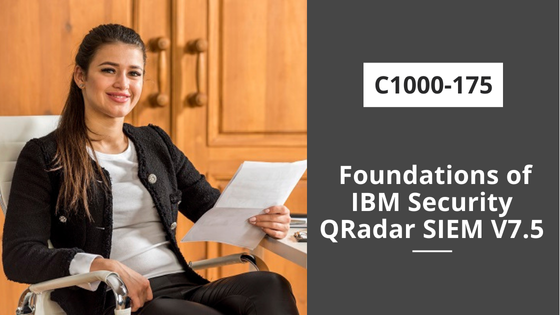Full Name: Foundations of IBM Security QRadar SIEM V7.5
Exam Code: C1000-175
Certification Overview
An IBM Certified Associate – Security QRadar SIEM V7.5 is an individual with entry level knowledge and experience with QRadar SIEM V7.5. This individual understands foundational concepts of QRadar SIEM V7.5 through hands-on experience and formal and informal education. The associate has knowledge of the basic to intermediate tasks required in day-to-day use of QRadar SIEM V7.5.
Note: The function of specific apps, apart from those bundled with the product, is out of scope, but the concept of extending the capability of using apps is in scope. This exam does not include the SaaS offering QRadar on Cloud (QRoC).
IBM Foundations of Security QRadar SIEM Exam Summary:
Exam Name
|
IBM Certified Associate - Security QRadar SIEM V7.5
|
Exam Code
|
C1000-175
|
Exam Price
|
$200 (USD)
|
Duration
|
90 mins
|
Number of Questions
|
62
|
Passing Score
|
66%
|
| Books / Training | |
Sample Questions
|
|
Practice Exam
|
IBM C1000-175 Exam Syllabus Topics:
| Topic | Details | Weights |
| SIEM Concepts | - Log Management - Event Correlation and Analytics - Incident Monitoring and Security Alerts - Compliance Management and Reporting |
10% |
| QRadar Architecture | - Understand the logical components of QRadar - Understand QRadar appliances - Understand how QRadar can be deployed in different environments |
10% |
| User Interface | - Describe main portions of the QRadar SIEM GUI | 05% |
| Extensions | - Illustrate the use of the IBM Security App Exchange - Understand the QRadar Assistant App - Describe the installed apps |
05% |
| Flows | - Describe flows versus events - Manage flow sources - Explain the basic use case for QNI versus QIF - Understand that there are three inspection levels in QNI |
06% |
| Rules and Building Blocks | - Create and configure rules - Understand the use of rule types - Understand rules tests - Understand rule responses - Create and manage building blocks - Describe Local versus Global correlation |
10% |
| Working with Offenses | - Describe the basic offense lifecycle - Manage offenses |
08% |
| Search, Filtering, and AQL | - Utilize different search types - Conduct search management - Use Filters |
08% |
| Assets | - Explain how the asset database gets populated - Describe the value of the vulnerability information in the asset database - Demonstrate use of the asset database |
05% |
| Reporting and Dashboards |
- Generate, modify and interpret reports using QRadar templates |
06% |
| Events |
- Describe the processes of data ingestion |
10% |
| Configuration and Tuning |
- Understand network hierarchy |
06% |
| QRadar System Errors |
- Monitor QRadar Notifications and error messages |
06% |
| User and Role Management |
- Understand user roles |
05% |





0 comments:
Post a Comment